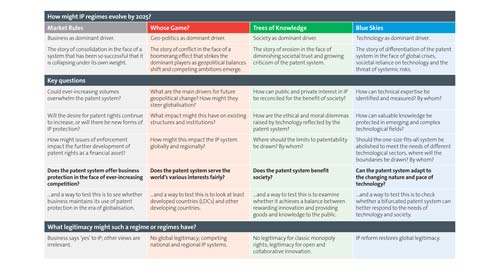Knowledge Risk
Knowledge is the currency of the global economy.
Whilst difficult to produce knowledge of value, it can subsequently be scaled and reproduced almost infinitely at negligible cost.
We have identified several key issues central to understanding knowledge risk, namely:
- How best to reward and protect innovation?
- Is there knowledge so valuable it should remain a common good?
- Are there models other than intellectual property rights that are more suited to the interdisciplinary nature and accelerated pace of technological innovation?
Anticipating and understanding knowledge risk is critical for any organisation that might have knowledge of value – or might be impinging upon someone else's. In today's knowledge-based global economy, knowledge of value, and how best to produce, distribute, license and protect it is important for survival.
An example of our work
EPO Scenarios on the Future of Intellectual Property and Patenting
How might knowledge regimes evolve by 2025? What global legitimacy might such regimes have?
Elahi, S, Carmichael, G, Karachalios, K, Müller, M, Rutz, B. (2007). European Patent Office, Munich.
This project was undertaken for the European Patent Office (EPO), one of the largest intellectual property organisations in the world and the regional patent granting authority for Europe.
The patent system
Today, almost everyone, regardless of their whereabouts, their particular interests or profession, or even their realisation, is impacted by some aspect of intellectual property as they go about their daily lives. This intrusion has led to a growing interest in the system, so that what was once a legal and technical backwater has now become an issue at the forefront of debate about trade, development, technology, society and ethics.
The patent system is one of the most successful and important components of the system for managing intellectual property rights (IPR). These rights encompass trademarks, copyright, design rights, appellations of origin as well as patents and other forms of intellectual property (IP) and together they underpin the global knowledge economy. While the public perceives the inextricable link between the individual components under the IPR umbrella, this linkage is perhaps not acknowledged by the experts within each field. However, the stresses within one set of rights, such as copyrights, can profoundly affect other rights, such as the patent system.
The patent system underpins scientific and technological advancement. It grants exclusive territorial rights in return for public disclosure, so enabling others to build upon the innovation of their predecessors – 'standing on the shoulders of giants'. However, what began as a 19th century set of discrete national rules to improve and protect national competitiveness has now has now been pulled and stretched to accommodate a 21st century networked society with many diverse stakeholders. Today's globally focused information world brings with it complex and dynamic pressures which are already impacting upon the ability of the existing patent system to cope. Business models that sustained businesses for decades are in the throes of a radical transformation, thereby forcing change. There is massive disintermediation taking place in the channels of distribution through the web and other new communication technologies, as well as a relentless drive for increased efficiencies in operations and administration, thereby changing the nature and pace of knowledge acquisition and technological change. Clearly, for the patent system, business as usual is an likely option.
Driving forces impacting upon the global patent system
Our analysis identified five driving forces crucial to the future of the patent system – all beyond the areas normally associated with IPR. These are:
- Power
i.e. the redefinition of the traditional power structure forced by globalisation. Power has historically been concentrated in the hands of established authority, but these established sources of authority, such as governments, are being challenged by many new powerful actors. These include multinational corporations, civil society organisations and global networks of political and special interest movements; international bodies; emerging economies and regional trade blocs; as well as other players, such as private equity investors, many forming novel cross–cutting global alliances.
- Global jungle
i.e. economic, social and political competitive flattening of the world caused by globalisation. This integration of national economic systems through international trade, investment and capital flows as well as increased social, cultural and technological interaction has created economies of scale and resulted in fierce competition between a multiplicity of players that include countries, regions, city states, market sectors, global companies, business models, consumer markets and workforces, universities as well as cultures. In this global jungle there are many who are ill–equipped to adapt.
- Rate of change
i.e. the growing tension between the quickening pace of global economic markets, the rate of change in technology and short–term political cycles and the longer term temporal cycles of political and legal institutions such as the IP system, the environment as well as the psychology of the human brain. There is a growing mismatch between short–and long–term interests and goals, making it difficult to address certain slow variables such as environmental degradation, climate change or institutional governance.
- Systemic risks
i.e. the major risks created by our dependency on the complex natural and man–made systems that support humanity. The nature of these risks is changing from traditional ones (such as natural hazards) to complex systemic risks. There are many stresses and uncertainties that together could threaten the integrity of interconnected systems, whether they're economic, social or environmental. In addition, growing population pressures have given rise to a number of regional, ethnic and cultural conflicts, the rise of worldwide terrorism and the rising impact of environmental problems, thereby increasing systemic risks.
- Knowledge paradox
i.e. the changing nature and availability of knowledge as a result of communication technologies. Today, knowledge access, search, management, production and ownership are all rapidly changing. The transformation of data into information and then into knowledge – information that can be utilised to build capabilities – is also far from straightforward. Technology has made information more accessible and counterfeiting simpler, eroding the control a patent holder once exerted. In addition, the speed of technological obsolescence and the clogged IP system make it harder to achieve value from traditional patent usage. This forces us to question the equation that more information equals more knowledge and then to establish if there are cheaper, quicker methods of protecting and exploiting knowledge than the patent system.
Four scenarios
In each of the scenarios, the driving forces described play out differently, so creating their own stories of the future. These are:
Market Rules
A world where business is the dominant driver
It's a story of the consolidation of a system so successful that it is collapsing under its own weight. New forms of subject matter – inevitably including further types of services – become patentable and more players enter the system. The balance of power is held by multinational corporations with the resources to build powerful patent portfolios, enforce their rights in an increasingly litigious world and drive the patent agenda. A key goal is the growth of shareholder value. Patents are widely used as a financial tool to achieve that end. In the face of ever–increasing volumes of patent applications, various forms of rationalisation of the system occur and it moves to mutual recognition of harmonised patent rights. The market decides the fate of the system, with minor regulation of visible excesses. Patent trolling, anticompetitive behaviour and standards issues all come under scrutiny.
Whose Game?
A world where geopolitics is the dominant driver
This is the story of a boomerang effect which strikes today's dominant players in the patent world as a result of changing geopolitical balances and competing ambitions. The developed world increasingly fails to use IP to maintain technological superiority; new entrants try to catch up so they can improve their citizens' living standards. But many developing world countries are excluded from the process, and work instead within a 'communal knowledge' paradigm. Nations and cultures compete. The new entrants become increasingly successful at shaping the evolution of the system, using it to establish economic advantage, adapting the existing rules as their geopolitical influence grows. Enforcement becomes increasingly difficult and the IP world becomes more fragmented. Attempts are made to address the issues of development and technology transfer.
Trees of Knowledge
A world where society is the dominant driver
In this story, diminishing societal trust and growing criticism of the IP system result in its gradual erosion. The key players are popular movements – often coalitions of civil society, businesses, concerned governments and individuals – seeking to challenge existing norms. This Kaleidoscope Society is fragmented yet united – issue by issue, crisis by crisis – against real and perceived threats to human needs: access to health, knowledge, food and entertainment. Multiple voices and multiple world views feed popular attention and interest, with the media playing an active role in encouraging debate. This loose 'knowledge movement' echoes the environmental movement of the 1980s, initially sparked by small, established special interest groups but slowly gaining momentum and raising wider awareness through alliances such as the A2K (Access to Knowledge) movement. The main issue is how to ensure that knowledge remains a common good, while acknowledging the legitimacy of reward for innovation.
Blue Skies
A world where technology is the dominant driver
The final story revolves around a split in the patent system. Societal reliance on technology and growing systemic risks force this change; the key players are technocrats and politicians responding to global crises. Complex new technologies based on a highly cumulative innovation process are seen as the key to solving systemic problems such as climate change, and diffusion of technology in these fields is of paramount importance. The IP needs of these new technologies come increasingly into conflict with the needs of classic, discrete technologies. In the end, the patent system responds to the speed, interdisciplinarity and complex nature of the new technologies by abandoning the one–size–fits–all model: the former patent regime still applies to classic technologies whilst the new ones use other forms of IP protection, such as the licence of rights. The patent system increasingly relies on technology, and new forms of knowledge search and classification emerge.
4 scenarios for the Future of Intellectual Property and Patenting
– Click to enlarge
Summary
Our analysis indicates that this vital system is one facing profound systemic change. This transition has happened so quickly that it has been hard for those within its hermetic world to grasp this and adapt to these changing conditions. The expanding stresses and strains within the patent system, caused in no small part by the need to cope with the growing demands of an ever–increasing number of global players, have created blockages, growing uncertainty for business and societal questioning. These tensions are being exacerbated by the driving forces pressuring on the system. There are many voices questioning the system at present. Some of these voices will grow louder over time, some will fade away. However, it would be unwise to ignore their messages, nor allow them to drown out the underlying benefits of the system. The patent system is far too complex, and the issues it touches on far too diverse, for any single group of stakeholders to decide its future.
There are no simple answers to resolve the tensions inherent within the patent system. At the heart is the issue of balance between multiple conflicting requirements – those of private and public interests, developing and developed countries, small inventors and global multinationals, traditional technological fields and emerging technologies, to name but a few. At the core is the growing importance of knowledge, and the question is how best to adapt to the fundamental changes in the way in which knowledge is being produced and used within global society.









